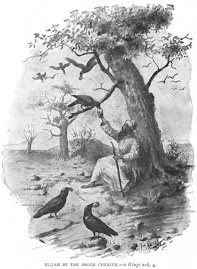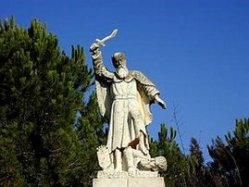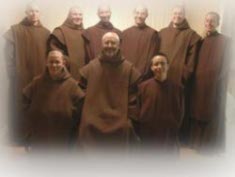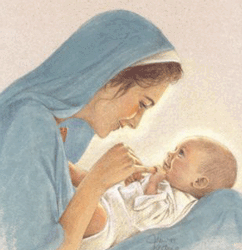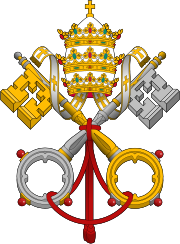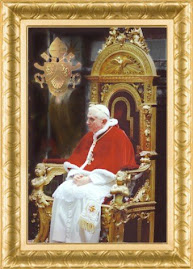Good reading for reflection how truly and deeply Marian is and should always be the Order Carmelites.

The last part of Bl Titus Brandsma lecture "The Brothers of Our Lady"
Mary in Us as Living Through Us.
There is, however, yet another profound idea in the devotion to Mary on Carmel. It is based on the former indeed, and we cannot say that it was unknown in the first stages of our Order's history, even though it was more prominent in later times. I have called it the union with Mary. If we wish to conform ourselves to Mary in order to enjoy more fully the intercourse with God, by following her example, we should obviously become other Marys. We ought to let Mary live in us. Mary should not stand outside the Carmelite, but he should live a life so similar to Mary that he should live with, in, through, and for Mary. Even in the Middle Ages, in the first period of the Order's history, the idea was propagated that we should be serfs of Mary; in those days, even a stronger term, "slave," was used. In the 18th century, Blessed Grignion de Montfort drew attention again to this most vigorous Marian devotion. He wrote a work on True Devotion to Mary but it remained hidden during his lifetime and even for years after his death. It was not until 1842 that it was discovered, published and spread to all countries. It is a glorious utterance of Marian life. However, it is not new. Not only did the idea exist even in the Middle Ages, but also in later times it was brilliantly elaborated in the mystic school of Carmel. The admirers of the True Devotion to Mary by Blessed Grignion de Montfort admit willingly that the Saint had a remarkable prototype in the mystic writings of one of the dominant figures of later Carmelite mysticism, the Provincial of the Dutch Calced Carmelites, Michael of St. Augustine (Ballaert), in the middle of the 17th century. His treatise on Devotion to Mary was printed two years before Blessed Grignion de Montfort was born and was reprinted during the latter's life in Latin and Dutch. As he sees in Mary the Mediatrix of all graces, he says that just as the grace of God or of the Holy Ghost, is communicated to those who are susceptible of it, makes them active and excites divine life in them, so all graces, received through Mary and the spirit of Mary, will excite in us a truly Marian life. He wants the spirit of Mary to dwell in us so that we all may live in that spirit. As we should live in God, work and labour in Him, live and die in Him, so we can live in Mary because of the intimate union of Mary with God and because of her election to the office of Mediatrix of all graces.
Carmelite - Another Mary.
However beautiful the description of the devotion to Mary in the works of Fr. Michael of St. Augustine may be, there is yet another representation of that devotion living in the tradition of Carmel, which in the above-mentioned work is indeed touched upon but not elaborated. Still, in order to sound the deepest depths of the school of Carmel, it is necessary to see its characteristic features. We should attain similarity to Mary, especially in that we recognise her as the highest perfection which human power by the grace of God has attained. This perfection can also be developed in us to a considerable extent, if we reflect ourselves in Mary and unite ourselves to her. This ought to be the aim of our devotion to Mary, that we be another mother of God, that God should be conceived in us also, and brought forth by us. The mystery of the Incarnation has revealed to us how valuable man is to God, how intimately God wants to be united to man. This mystery draws the attention of our minds to the eternal birth of the Son from the Father as the deepest reason for this mystery of Love. In the celebration of the three Holy Masses on Christmas, the birth from the Father is first celebrated, secondly from the Holy Virgin Mary, thirdly God's birth in ourselves. This is not done without significance and this threefold birth must be understood to be a revelation of one eternal Love. It should be ever Christmas to us and we should always remember that threefold birth as phases of one great process of love. Mary is the daughter of God the Father, Mother of God the Son and Spouse of God the Holy Ghost. In her that threefold birth has been realised. We also have been chosen by the Holy Trinity for a dwelling, to share the privileges which we admire in Mary, but which God is willing to bestow on us also. Seen in this way, I should like to say that "the mystery of the Incarnation is another summary of Carmelite mysticism, Carmelite spiritual life."
Sunflowers in the Garden of Carmel.
The devotion to Mary is one of the most delightful flowers in Carmel's garden. I should like to call it a sunflower. This flower rises up high above the other flowers. Borne aloft on a tall stem, rich in green leaves, the flower is raised yet higher from among the green foliage. It is characteristic of this flower to turn itself towards the sun and moreover it is an image of the sun. It is a simple flower; it can grow in all gardens and it is an ornament to all. It is tall and firm and has deep roots like a tree. In the same way, no devotion is firmer than that to Mary. The fresh foliage, the green leaves point to the abundance of virtues, with which the devotion to Mary is surrounded. The flower itself represents the soul created after God's image in order to absorb the sunlight of God's bounty. Two suns shining into each other, one radiant with an unfathomable light, the other absorbing that light, basking in that light and glowing like another sun, but so enraptured by the beams of the Sun which shines on it, that it cannot turn itself away from Him, but can only live for Him and through Him. Such a flower was Mary. Like her, so may we, flowers from her seed, raise our flower-buds to the Sun, Who infused Himself into her, and will transmit to us also the beams of His light and warmth.
Mary in Us as Living Through Us.
There is, however, yet another profound idea in the devotion to Mary on Carmel. It is based on the former indeed, and we cannot say that it was unknown in the first stages of our Order's history, even though it was more prominent in later times. I have called it the union with Mary. If we wish to conform ourselves to Mary in order to enjoy more fully the intercourse with God, by following her example, we should obviously become other Marys. We ought to let Mary live in us. Mary should not stand outside the Carmelite, but he should live a life so similar to Mary that he should live with, in, through, and for Mary. Even in the Middle Ages, in the first period of the Order's history, the idea was propagated that we should be serfs of Mary; in those days, even a stronger term, "slave," was used. In the 18th century, Blessed Grignion de Montfort drew attention again to this most vigorous Marian devotion. He wrote a work on True Devotion to Mary but it remained hidden during his lifetime and even for years after his death. It was not until 1842 that it was discovered, published and spread to all countries. It is a glorious utterance of Marian life. However, it is not new. Not only did the idea exist even in the Middle Ages, but also in later times it was brilliantly elaborated in the mystic school of Carmel. The admirers of the True Devotion to Mary by Blessed Grignion de Montfort admit willingly that the Saint had a remarkable prototype in the mystic writings of one of the dominant figures of later Carmelite mysticism, the Provincial of the Dutch Calced Carmelites, Michael of St. Augustine (Ballaert), in the middle of the 17th century. His treatise on Devotion to Mary was printed two years before Blessed Grignion de Montfort was born and was reprinted during the latter's life in Latin and Dutch. As he sees in Mary the Mediatrix of all graces, he says that just as the grace of God or of the Holy Ghost, is communicated to those who are susceptible of it, makes them active and excites divine life in them, so all graces, received through Mary and the spirit of Mary, will excite in us a truly Marian life. He wants the spirit of Mary to dwell in us so that we all may live in that spirit. As we should live in God, work and labour in Him, live and die in Him, so we can live in Mary because of the intimate union of Mary with God and because of her election to the office of Mediatrix of all graces.
Carmelite - Another Mary.
However beautiful the description of the devotion to Mary in the works of Fr. Michael of St. Augustine may be, there is yet another representation of that devotion living in the tradition of Carmel, which in the above-mentioned work is indeed touched upon but not elaborated. Still, in order to sound the deepest depths of the school of Carmel, it is necessary to see its characteristic features. We should attain similarity to Mary, especially in that we recognise her as the highest perfection which human power by the grace of God has attained. This perfection can also be developed in us to a considerable extent, if we reflect ourselves in Mary and unite ourselves to her. This ought to be the aim of our devotion to Mary, that we be another mother of God, that God should be conceived in us also, and brought forth by us. The mystery of the Incarnation has revealed to us how valuable man is to God, how intimately God wants to be united to man. This mystery draws the attention of our minds to the eternal birth of the Son from the Father as the deepest reason for this mystery of Love. In the celebration of the three Holy Masses on Christmas, the birth from the Father is first celebrated, secondly from the Holy Virgin Mary, thirdly God's birth in ourselves. This is not done without significance and this threefold birth must be understood to be a revelation of one eternal Love. It should be ever Christmas to us and we should always remember that threefold birth as phases of one great process of love. Mary is the daughter of God the Father, Mother of God the Son and Spouse of God the Holy Ghost. In her that threefold birth has been realised. We also have been chosen by the Holy Trinity for a dwelling, to share the privileges which we admire in Mary, but which God is willing to bestow on us also. Seen in this way, I should like to say that "the mystery of the Incarnation is another summary of Carmelite mysticism, Carmelite spiritual life."
Sunflowers in the Garden of Carmel.
The devotion to Mary is one of the most delightful flowers in Carmel's garden. I should like to call it a sunflower. This flower rises up high above the other flowers. Borne aloft on a tall stem, rich in green leaves, the flower is raised yet higher from among the green foliage. It is characteristic of this flower to turn itself towards the sun and moreover it is an image of the sun. It is a simple flower; it can grow in all gardens and it is an ornament to all. It is tall and firm and has deep roots like a tree. In the same way, no devotion is firmer than that to Mary. The fresh foliage, the green leaves point to the abundance of virtues, with which the devotion to Mary is surrounded. The flower itself represents the soul created after God's image in order to absorb the sunlight of God's bounty. Two suns shining into each other, one radiant with an unfathomable light, the other absorbing that light, basking in that light and glowing like another sun, but so enraptured by the beams of the Sun which shines on it, that it cannot turn itself away from Him, but can only live for Him and through Him. Such a flower was Mary. Like her, so may we, flowers from her seed, raise our flower-buds to the Sun, Who infused Himself into her, and will transmit to us also the beams of His light and warmth.




